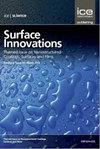Spatially resolved mapping of hydrogel stiffness during enzymatic degradation
IF 3.5
4区 材料科学
Q3 CHEMISTRY, PHYSICAL
引用次数: 1
Abstract
Atomic force microscopy force-volume technique was used to investigate the surface properties of two hydrogels during their enzymatic degradation. Agarose gels with concentrations of 0.5%, 1.0%, and 1.5% w/v were selected for the degradation study to show that the mechanical effects of degradation could be measured in a spatially resolved way on hydrogel surface. Agarase enzyme was used to degrade the agarose gels. The agarose gels were found to be heterogeneous with multiple stiffness domains that were degraded with different erosion rates. It was inferred that agarose gels contained both tightly and loosely packed regions. The loosely packed regions degraded first, followed by the regions that were packed more tightly. Second hydrogel containing hyaluronic acid and gelatin with 5% w/v hyaluronic acid and 5% w/v gelatin cross-linked in equal amounts were also studied. These hybrid gels were degraded either by using hyaluronidase or collagenase type IV. With hyaluronidase, gelatin was left on the surface as a homogenous layer. With collagenase, cross-linked hyaluronic acid remained on the surface. Post-degradation the hyaluronic acid rich surface had a stiffness of ∼20 kPa, while the gelatin rich surface stiffness was only ∼15 kPa.酶降解过程中水凝胶硬度的空间分辨图谱
采用原子力显微镜-力-体积技术研究了两种水凝胶在酶降解过程中的表面性质。选择浓度为0.5%、1.0%和1.5%w/v的琼脂糖凝胶进行降解研究,以表明降解的机械效应可以在水凝胶表面上以空间分辨的方式测量。琼脂糖酶用于降解琼脂糖凝胶。发现琼脂糖凝胶是不均匀的,具有多个硬度域,这些硬度域以不同的侵蚀速率降解。推断琼脂糖凝胶包含紧密和松散堆积的区域。松散堆积的区域首先退化,其次是堆积得更紧密的区域。还研究了含有透明质酸和明胶的第二水凝胶,其中5%w/v透明质酸与5%w/v明胶以等量交联。这些混合凝胶通过使用透明质酸酶或IV型胶原酶降解。使用透明质酶,明胶作为均匀层留在表面上。使用胶原酶,交联的透明质酸保留在表面。降解后富含透明质酸的表面硬度为~20 kPa,而富含明胶的表面硬度仅为~15 kPa。
本文章由计算机程序翻译,如有差异,请以英文原文为准。
求助全文
约1分钟内获得全文
求助全文
来源期刊

Surface Innovations
CHEMISTRY, PHYSICALMATERIALS SCIENCE, COAT-MATERIALS SCIENCE, COATINGS & FILMS
CiteScore
5.80
自引率
22.90%
发文量
66
期刊介绍:
The material innovations on surfaces, combined with understanding and manipulation of physics and chemistry of functional surfaces and coatings, have exploded in the past decade at an incredibly rapid pace.
Superhydrophobicity, superhydrophlicity, self-cleaning, self-healing, anti-fouling, anti-bacterial, etc., have become important fundamental topics of surface science research community driven by curiosity of physics, chemistry, and biology of interaction phenomenon at surfaces and their enormous potential in practical applications. Materials having controlled-functionality surfaces and coatings are important to the manufacturing of new products for environmental control, liquid manipulation, nanotechnological advances, biomedical engineering, pharmacy, biotechnology, and many others, and are part of the most promising technological innovations of the twenty-first century.
 求助内容:
求助内容: 应助结果提醒方式:
应助结果提醒方式:


